Abstract
This study investigates the effectiveness of different ventilation methods in reducing indoor air pollutants in newly constructed residential buildings, focusing on indoor air quality (IAQ) in Dubai. The paper highlights the growing concern for IAQ in response to residents’ increasing awareness of their well-being and environmental sustainability. The study examines the concentrations of formaldehyde (HCHO), volatile organic compounds (VOCs), and total volatile organic compounds (TVOC) in bedrooms and living rooms before and after implementing various ventilation methods during the construction phase. The findings indicate that mechanical exhaust ventilation, mainly through bathroom and kitchen exhaust fans, was highly effective in reducing HCHO levels. Combining kitchen and bathroom exhaust fans demonstrated the most significant reduction in HCHO concentrations. Similarly, reductions in VOCs, such as ethylbenzene, toluene, and xylene, were observed with different ventilation methods. Natural ventilation also proved effective in reducing pollutant concentrations. The results emphasize the importance of implementing appropriate ventilation strategies to improve IAQ in residential buildings. However, the study acknowledges the limitations of a single-location measurement and recommends further research to validate the findings across different building types and locations. Additionally, long-term studies are necessary to assess the sustained effects of ventilation methods on IAQ. The study highlights the significance of addressing IAQ concerns in residential buildings and suggests potential research directions to explore other ventilation strategies and their energy efficiency implications. Ultimately, this research contributes to developing healthier and sustainable living environments by promoting effective ventilation strategies to mitigate indoor air pollutants.
1. Introduction
In recent times, there has been a surge in social interest and demand surrounding indoor air quality (IAQ) in newly constructed residential buildings in Dubai [1,2]. This increased attention can be attributed to the growing awareness among residents increasingly prioritizing their physical and mental well-being and environmental concerns [3]. The Dubai Municipality standard for IAQ regulates that the air should have less than 0.08 parts per million of formaldehyde (HCHO), less than 300 micrograms of total volatile organic compound (TVOC), and less than 150 micrograms of suspended particulates in an eight-hour window of continuous monitoring pre-occupancy [4]. However, more strict enforcement of these standards is necessary, along with updates to these standards, as suggested by recommendations for adopting a standard recommended by the Eurovent Association (EN16798-3 Sup 2), which calls for lower concentrations of PM in the air [5]. Poor IAQ can lead to lowered immunity, susceptibility to viruses, respiratory issues, asthma, hypersensitivity, allergies, and even negative effects on children’s mental health [6].
Notably, with the advancement of construction methods, the construction period for residential buildings has been significantly reduced [7]. Consequently, it has become virtually impossible to eliminate harmful substances before occupants move into their apartments [8]. As a result, the indoor air quality in these residential buildings is progressively deteriorating over time [9]. Furthermore, due to the emphasis on energy conservation, reinforced insulation and high levels of airtightness are being implemented, which limits the amount of indoor ventilation available to residents [10]. This insufficiency in ventilation persists even during the occupancy phase [11].
Dubai’s landscape is witnessing a gradual increase in the height of high-rise apartments, accompanied by a shift in design towards tower structures [12]. However, these developments do not actively utilize natural ventilation, contributing to IAQ concerns [13].
The construction industry in the UAE, including Dubai, is expected to grow steadily and record a Compound Annual Growth Rate (CAGR) of 3.9% during 2022–2026, with the construction output in the country expected to reach AED 286,350.5 million by 2026 [14]. Factors such as government spending on construction activities, the development of smart cities, and low lending rates fuel this growth. However, these trends, increasing building heights and a lack of natural ventilation, could exacerbate the IAQ issue if not adequately addressed. Hence, there is an urgent need for proactive measures to address the management of IAQ in residential buildings [15].
Suppose we classify the control of indoor air pollutants based on the building’s life cycle. In that case, it can be categorized into three stages: the planning stage during construction, the construction stage itself, and the operational stage during occupancy [16]. Regarding the methods for controlling indoor pollutants, there are two primary approaches: generation control, which aims to block or suppress the source of pollutants, and dilution control, which involves diluting the pollutants by introducing fresh outdoor air [17]. Additionally, there are direct control methods to address pollutants at their source [18]. Among these methods, effective removal of indoor air pollutants can be achieved through dilution control using ventilation systems, some of which incorporate total heat exchangers to recover waste heat [19]. As a result, there has been a significant increase in the number of patent applications related to ventilation systems due to the variety of available options [20].
However, the current dominant ventilation control method, employing heat exchangers, is primarily implemented during the operational stage of a building’s life cycle, resulting in delayed removal of pollutants emitted by building materials and increased operating costs such as energy expenses [21]. Consequently, it is more efficient to control dilution through ventilation systems during construction before occupants move into the building [22].
Two examples of dilution control methods through pre-move-in ventilation are the Bake-Out and Flush-Out methods [23]. In the case of the Bake-Out method, Dubai adopts a unique continuous cooling approach, and there is insufficient data regarding the appropriate temperature, duration, and ventilation frequency for this method [24]. Additionally, for newly constructed apartments in emerging neighborhoods, there is a risk of missing the optimal timing for conducting a Bake-Out before occupancy [25]. As for the Flush-Out method, application in Dubai is still premature due to specialized equipment requirements [26].
Therefore, this study aims to measure and analyze the indoor air quality (IAQ) levels of HCHO and volatile organic compounds (VOCs) in bedrooms and living rooms [27]. The ventilation method, a dilution control method easily manipulated to control indoor air pollutants, was applied during the construction stage before the occupation of the apartment [28].
The ventilation methods encompass natural ventilation utilizing wind pressure differences by opening windows and doors, mechanical exhaust through forced air extraction via fans in kitchens and bathrooms, and a combination of natural and mechanical ventilation [29]. These methods are classified accordingly.
The IAQ measurements evaluate the initial concentration of pollutants immediately after apartment construction [30]. After three weeks of implementing each ventilation method, the concentration changes are compared and analyzed to assess the efficiency of pollutant reduction associated with each ventilation method [31].
2. Materials and Methods
2.1. IAQ Standards
Over the past decade, Sick Building Syndrome (SBS), primarily caused by releasing HCHO and VOCs from building materials, has emerged as a prominent research topic [32]. SBS symptoms encompass various discomforts such as eye, nose, and throat irritation, headaches, fatigue, reduced concentration, occasional dizziness, nausea, and chest tightness [33]. Table 1 offers a comprehensive summary of the impact of each hazardous substance on human health.

Table 1.
The effects of hazardous substances on the human body.
Table 2 presents the IAQ standards of the World Health Organization (WHO), outlining their comprehensive regulations [34]. These standards not only adhere to the guidelines set by the WHO but also provide detailed specifications based on the duration of exposure [35].

Table 2.
WHO IAQ standard.
2.2. IAQ Control and Ventilation System
IAQ control methods can be categorized into three main types: generation control, dilution control, and removal control [36]. Generation control focuses on managing the emission of harmful substances from various building and construction materials during the early stages of construction, with the aim of reducing their concentration and improving IAQ [37]. Dilution control, commonly implemented through ventilation, involves introducing fresh outdoor air to dilute the polluted indoor air [38]. This method has been widely employed to address IAQ concerns. Removal control, on the other hand, is a more proactive approach compared to the previous two methods. It aims to quickly restore a pleasant indoor air environment through air purifiers or decomposable adsorbents [39].
In recent years, there has been notable progress in developing eco-friendly building materials to minimize the generation of harmful substances such as HCHO and VOCs [40]. However, limitations arise due to the inherent characteristics of adhesives and paints used in construction [41]. Simultaneously, with the growing public interest in IAQ, the use of air purifiers has witnessed a rapid increase [42]. However, it is essential to note that these devices are primarily effective in removing indoor dust and particulate matter through filters but not as proficient in eliminating gaseous pollutants such as HCHO and VOCs [43]. To address these specific pollutants, the installation of separate activated carbon filters, chemical filters, or similar systems is necessary [44].
Another concern is the tendency to focus on localized control of air purifiers rather than achieving comprehensive air quality control throughout the apartment building [45]. In contrast, as a dilution control method, ventilation involves replacing and diluting polluted indoor air with fresh outdoor air [46]. This method offers relative ease of implementation compared to generation and removal control [47]. It allows for localized and general ventilation tailored to the resident’s needs. Additionally, ventilation can improve indoor air quality while helping regulate temperature and humidity levels within the building, thus preventing mold growth and potential damage to floors and walls [48]. Nonetheless, a significant challenge is that natural ventilation through windows and doors often falls short of eliminating pollutants [49].
In Japan, the issue of SBS has been recognized for several years, leading to the development of technologies mandating eco-friendly materials and the implementation of active ventilation systems. Ventilation methods are meticulously classified based on region, building use, and confidentiality. The comprehensive plan is to ensure continuous 24 h ventilation for the entire building, employing hybrid systems that combine air conditioning and natural ventilation [50].
Similarly, active European research is being conducted to apply hybrid systems that seamlessly integrate mechanical ventilation with natural ventilation to achieve energy-efficient ventilation and air conditioning solutions for diverse residential buildings [51].
In Dubai, natural ventilation methods, such as window gaps and entrances, take precedence, but a combination of forced ventilation and local ventilation is also employed [52]. This combination effectively removes humidity and odors from kitchens and eliminates bathroom odors. Specifically, kitchen ventilation systems are implemented to mitigate contaminants from gas ranges used in enclosed spaces [53]. For high-rise apartment buildings exceeding 30 floors, smooth exhaust ventilation becomes challenging due to the chimney effect [54]. Consequently, it becomes crucial to adopt forward-thinking design techniques, including the discreet placement of stairwells or rooftop exits and the incorporation of first-floor lobbies (windproof rooms) [55].
2.3. Ventilation Amount by Wind Pressure Difference
The pressure disparity between the interior and exterior of the building envelope serves as the driving force for ventilation through openings [56]. Ventilation occurs at locations with a differential in pressure [57]. The magnitude of airflow through the building is directly correlated with the pressure difference [58]. The pressure difference can be expressed as a function proportional to the square of the wind speed, and the quantity of ventilation through the opening is directly proportional to the square root of the pressure difference [59]. The ventilation volume is proportionate to the wind speed [60]. The equation for quantifying the ventilation quantity is as follows (Equation (1)):
- Q: ventilation amount (m3/s);
- A: inlet area (m2);
- v: flow speed (m/s);
- E: opening efficiency;
- When the wind blows perpendicular to the opening: 0.5–0.6;
- When b, the wind blows at an angle of 45° to the opening: 0.25–0.3.
When the inlet area is equal to the outlet area, the formula is applicable. However, in cases where the inlet and outlet areas differ, it is necessary to calculate and apply a correction factor, as presented in Table 3 [61]. This correction factor should be multiplied to obtain accurate results.

Table 3.
WHO IAQ standard.
2.4. IAQ Measurement by Ventilation Methods
2.4.1. Measurement Overview
The focus of this study was to measure IAQ in the Hera Tower located in Dubai Sports City just before its completion (Figure 1). During the measurement phase, the building was in a pre-inspection stage, with finishing work nearing completion [62]. The move-in process had been scheduled for 22 January 2022, and the IAQ measurement was planned 30 days before move-in (2–23 December 2021).
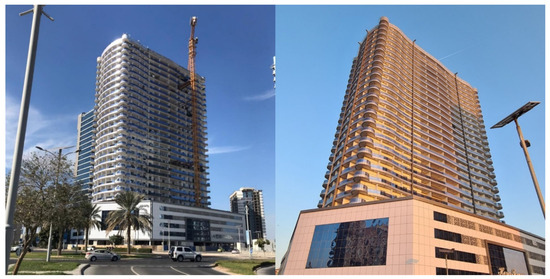
Figure 1.
Hera Tower in Dubai Sports City.
The measurement locations were, specifically, the bedrooms and living rooms of 2-bedroom units (145.4 m2) situated on floors 11 to 15, primarily targeting the middle floors of the building (Figure 2). The measurements encompassed assessing HCHO and VOC levels in the indoor air (Figure 3) [63]. To analyze the influence of external factors such as ventilation, temperature, humidity, and air circulation on these substances, meteorological conditions, both indoors and outdoors, were measured twice daily at 10:00 a.m. and 6:00 p.m. over three weeks at the designated measurement site [64].
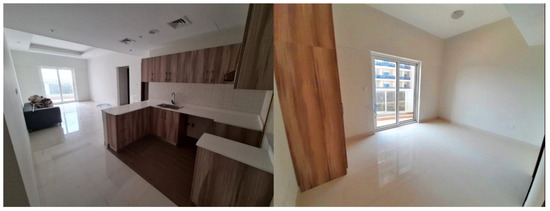
Figure 2.
Living room (Left) and bedroom (Right) at Hera Tower in Dubai Sports City.
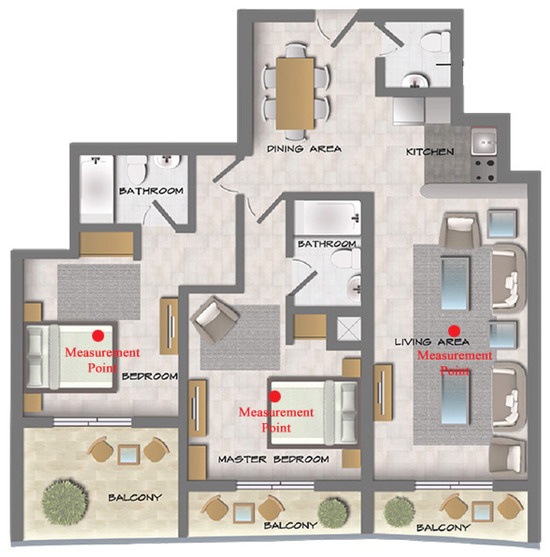
Figure 3.
Measurement points.
2.4.2. Measurement Condition and Analysis Method
To comprehensively assess the IAQ of the targeted units, the environment was subjected to measurement using the specific measurement methods and equipment outlined in Table 4. For the analysis of VOCs, a gas chromatograph coupled with a mass spectrometer (GC/MS) was utilized [65]. To analyze HCHO, a high-performance liquid chromatograph (HPLC) was employed [66].

Table 4.
Measurement method and equipment.
To establish a calibration curve for the volatile organic compounds, a TO-14 standard gas containing each component at a concentration of 100 parts per billion (ppb) was utilized [67]. To create a calibration curve for aldehyde analysis, a standard solution necessary for calibration was prepared by diluting a purchased HCHO standard solution (carb carbonyl-DNPHmix, 200 ppm) with an acetonitrile solution [68]. Each standard solution was analyzed using HPLC, and a calibration curve was subsequently generated based on the individual component’s area response [69].
The measurement conditions for each ventilation method were categorized into three main types: natural ventilation, mechanical exhaust, and mixed ventilation utilizing both natural and mechanical exhaust [70]. Three cases were considered for the bedroom, while four were examined for the living room, as outlined in Table 5.

Table 5.
Measurement conditions by ventilation methods.
To assess the concentration changes in IAQ based on the ventilation method, the initial IAQ measurements were conducted on 2 December 2021, during the pre-inspection stage following the completion of finishing work. The final IAQ measurements were taken on 3 December 2022, three weeks after the aforementioned period (2 December to 22 December).
During the measurement period, Dubai was experiencing the winter season, with the indoor temperature consistently maintained above 20 °C. To ensure consistent conditions for each ventilation method, the natural ventilation cases involved arriving at the measurement site every day at 10:00 a.m. for three weeks [71]. During this time, the bedroom window and the balcony door were opened while the bedroom or front door remained closed. At 6:00 p.m. on the same day, the balcony bedroom window and living room door were closed, and natural ventilation was set to operate for eight hours [72]. Regarding the mechanical exhaust method, the bathroom exhaust fan and kitchen hood fan were operated for each case at 10:00 a.m., and their power was turned off at 6:00 p.m., resulting in an eight-hour operation period [73].
2.4.3. Ventilation Amount by Different Methods
In estimating the ventilation quantity, the commonly employed experimental approach, instead of simulation-based methods, involves actual measurements utilizing the tracer gas technique through mock-up tests [74]. However, for this particular study, the ventilation conditions were implemented for three weeks in the bedrooms and living rooms of the apartments before occupancy [75]. Therefore, the ventilation quantity through natural ventilation was calculated based on the airflow measurements taken in front of the balcony [76].
The calculation formula Q = E × A × v was referenced to determine the natural ventilation quantity in the bedrooms and living rooms [77].
The opening efficiency (E) was considered under the assumption of a perpendicular airflow. At the same time, the correction factor for the outlet/inlet area accounted for the scenario where the bedroom window facing the balcony was open, the living room door was open, and the front door was closed. A value of 0.34, representing the minimum correction factor, was adopted. Consequently, Table 6 presents the calculated natural ventilation quantities for the bedrooms and living rooms (1102, 1302, 1104, and 1404), resulting from the inflow of airflow from the balcony. During the measurement period, as part of calculating ventilation volume, the finishing work was still ongoing, marking the pre-inspection phase before apartment occupancy. Consequently, the front door remained open, the bedroom window was closed, and the exhaust fan was turned off. Due to these circumstances, it was challenging to maintain a consistent and constant level of ventilation, resulting in an environmental variable.

Table 6.
Measurement conditions by ventilation methods.
3. Results
3.1. HCHO
Based on the measurement of HCHO levels in the bedroom of a newly constructed apartment, as illustrated in (Figure 4), the initial concentration immediately after construction was recorded at 50.67 μg/m3. Following three weeks of ventilation using different methods, the HCHO concentrations observed were 48 μg/m3 (1102), 41.8 μg/m3 (1202), and 48.4 μg/m3 (1302). The mechanical exhaust ventilation method (1202) demonstrated excellent results in reducing HCHO levels.
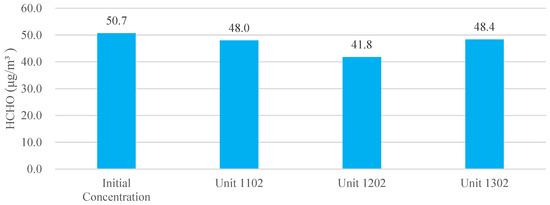
Figure 4.
Changes in HCHO concentration in the bedroom.
Based on the measurements conducted for HCHO in the living room, as depicted in Figure 5, the initial concentration immediately after construction was recorded at 57.33 μg/m3. Following three weeks of ventilation using different methods, the HCHO concentrations observed were 37.3 μg/m3 (1104), 32.8 μg/m3 (1204), 22.4 μg/m3 (1304), and 38.9 μg/m3 (1404). Notably, the most significant reduction in HCHO levels was observed in case 1204, where the kitchen hood fan was operated in the living room, and in case 1304, where both the kitchen hood fan and bathroom exhaust fan were operated simultaneously.
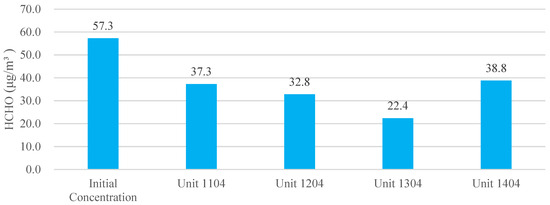
Figure 5.
Changes in HCHO concentration in the living room.
When evaluating the concentration changes of HCHO in the bedroom after three weeks of ventilation, it was found that case 1102 and case 1302 achieved a pollutant reduction rate of 5%, while case 1202, which utilized a bathroom fan, achieved an 18% reduction.
Regarding the living room measurements after three weeks, case 1104, employing natural ventilation, achieved a 35% reduction in HCHO pollutants. Case 1204, utilizing the kitchen exhaust fan, achieved a 43% reduction. Case 1304, employing both the kitchen exhaust fan and bathroom fan, achieved a 61% reduction, and case 1404, utilizing a mixed method, achieved a 32% reduction. Notably, the ventilation method employing the kitchen exhaust fan and bathroom fan demonstrated the most significant improvement in reducing HCHO levels.
However, it is essential to acknowledge that all measured values fell below the WHO recommended standard for IAQ for HCHO, which is set at 210 μg/m3. These results indicate a commendable achievement in maintaining good IAQ standards.
3.2. VOCs
3.2.1. Benzene, Ethylbenzene, Stylene
After conducting measurements in the bedroom of a newly constructed apartment, the concentrations of benzene, ethylbenzene, and styrene were determined. As indicated in Table 7, the initial concentrations immediately after construction were recorded at 1.5 μg/m3, 31.56 μg/m3, and 2.21 μg/m3, respectively. Notably, benzene exhibited a concentration of 360 μg/m3, while styrene exhibited a concentration of 300 μg/m3, both of which were significantly lower in comparison.

Table 7.
Results of VOC measurement by bedroom ventilation methods.
Upon measuring the concentrations of benzene, ethylbenzene, and styrene in the living room, the obtained results, presented in Table 8, revealed initial concentrations immediately after the construction of 1.08 μg/m3, 68.56 μg/m3, and 0.00 μg/m3, respectively. These concentrations were significantly lower than the 360 μg/m3 threshold for ethylbenzene and 300 μg/m3 for styrene.

Table 8.
Results of VOC measurement by living room ventilation methods.
Further analysis assessed the concentration changes specifically for ethylbenzene, which exhibited the highest emission levels among the measured compounds. The reduction rates of ethylbenzene pollutants after three weeks for each ventilation method in the bedroom were determined as 81% (1102), 70% (1202), and 77% (1302), as depicted in Figure 6. Similarly, in the living room, the concentration changes of ethylbenzene were evaluated for each ventilation method after three weeks, as illustrated in Figure 7. The reduction rates of ethylbenzene pollutants were determined to be 86% (1104), 89% (1204), and 100% (1304), while case 1404 showed a reduction rate of 66%.
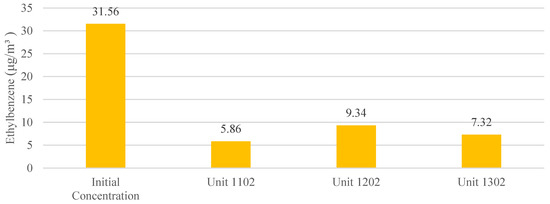
Figure 6.
Changes in ethylbenzene concentration in the bedroom.
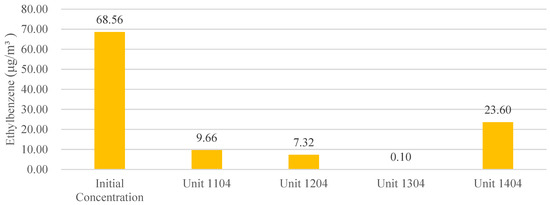
Figure 7.
Changes in ethylbenzene concentration in the living room.
3.2.2. Toluene, Xylene
The measurements conducted in the bedroom of the new apartment revealed concentrations of toluene and xylene, as depicted in Figure 8. The initial concentrations immediately after construction were 187.33 μg/m3 and 68.54 μg/m3, respectively. These concentrations exceeded the WHO recommended standard values of 1000 μg/m3 for toluene and 700 μg/m3 for xylene, indicating disappointing results. The concentration changes of toluene after three weeks in the bedroom were evaluated for each ventilation method, resulting in reduced rates of toluene pollutants of 93% (1102), 93% (1202), and 92% (1302). Similarly, the concentration changes of xylene after three weeks in the bedroom were assessed for each ventilation method, revealing reduction rates of xylene pollutants of 73% (1102), 61% (1202), and 70% (1302).
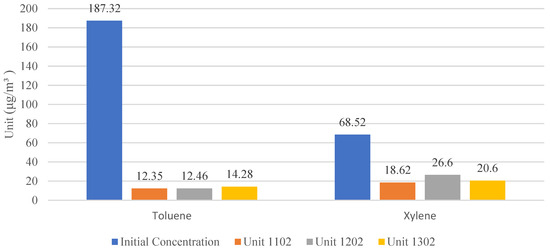
Figure 8.
Changes in toluene and xylene concentration in the bedroom.
Moving on to the living room, measurements of toluene and xylene were conducted, as illustrated in Figure 9. The initial concentrations immediately after construction were 268.59 μg/m3 and 158.89 μg/m3, respectively. Although these concentrations were 1.4 times higher than those observed in the bedroom, they fell below the WHO recommended standard values of 1000 μg/m3 for toluene and 700 μg/m3 for xylene.

Figure 9.
Changes in toluene and xylene concentration in the living room.
Regarding the concentration changes of toluene after three weeks in the living room for each ventilation method, the reduction rates of toluene pollutants were determined as 96% (1104), 96% (1204), 97% (1304), and 97% (1404). Similarly, the concentration changes of xylene after three weeks in the living room were examined for each ventilation method, resulting in reduction rates of xylene pollutants of 83% (1104), 86% (1204), 97% (1304), and 69% (1404).
3.2.3. TVOC
After conducting measurements of TVOC in the bedroom and living room of the newly constructed apartment, it was observed that the initial concentrations immediately after construction were 1319.58 μg/m3 and 1217.73 μg/m3, respectively, indicating relatively high levels.
Analyzing the concentration changes of TVOC in the bedroom after three weeks of applying ventilation methods, as depicted in Figure 10, it was found that unit 1102, utilizing natural ventilation, achieved a reduction rate of 92%, while unit 1202, employing a bathroom fan, and unit 1302, using a combination of bathroom fan and kitchen exhaust fan, exhibited reduction rates of 90% and 88%, respectively.
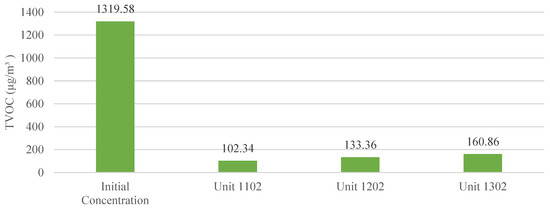
Figure 10.
Changes in TVOC concentration in the bedroom.
Similarly, when evaluating the concentration changes of TVOC in the living room after three weeks of ventilation, as shown in Figure 11, it was observed that unit 1104, utilizing natural ventilation, achieved an 88% reduction, while unit 1204, employing a kitchen exhaust fan, and unit 1304, using a combination of kitchen exhaust fan and bathroom fan, exhibited reduction rates of 90% and 96%, respectively. Unit 1404, involving a combined ventilation method, was excluded from the measurements due to an error. Therefore, regarding TVOC, the differences in reduction effects based on the type of ventilation method were relatively small. However, it was evident that dilution control through ventilation proved highly effective in reducing the initial TVOC concentrations.
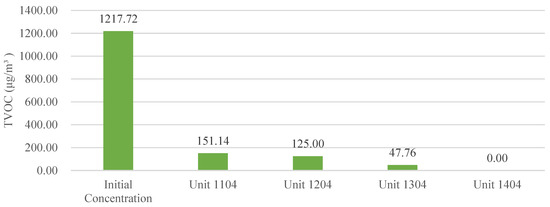
Figure 11.
Changes in TVOC concentration in the living room.
4. Discussion
The measurements conducted on IAQ parameters, including HCHO, VOCs, and TVOC, provided valuable insights into the effectiveness of different ventilation methods in reducing indoor pollutant concentrations in the newly constructed apartment.
The findings of this study reveal that the mechanical exhaust ventilation method (1202) was highly effective in reducing HCHO levels in both the bedroom and the living room. By utilizing a bathroom fan, this ventilation method achieved a substantial reduction in HCHO pollutants. Furthermore, the combined ventilation method, which involved the operation of the kitchen exhaust fan and the bathroom fan (1304), demonstrated significant improvement in reducing HCHO concentrations in the living room. These results emphasize the importance of employing effective ventilation strategies to mitigate the presence of HCHO and its potential health effects.
Regarding VOCs, the initial concentrations of benzene, ethylbenzene, and styrene were within acceptable limits. However, it should be noted that the levels of ethylbenzene were initially relatively high. Nevertheless, after three weeks of ventilation, significant reductions in ethylbenzene concentrations were observed across all ventilation methods. This indicates that ventilation reduces ethylbenzene pollutants, enhances IAQ, and promotes a healthier indoor environment.
The measurements of toluene and xylene concentrations in the bedroom and living room underscore the need for effective ventilation strategies to address these pollutants. While higher initial concentrations of toluene and xylene were observed in the bedroom compared to in the living room, notable reductions were achieved across all ventilation methods after three weeks. This highlights the effectiveness of proper ventilation in mitigating the presence of toluene and xylene, thus improving IAQ in residential spaces.
The measurements of TVOC concentrations demonstrate that dilution control through ventilation is highly effective in reducing the initial levels of TVOC. Although the differences in reduction effects based on the type of ventilation method were relatively small, these findings emphasize the significance of adequate ventilation in achieving better IAQ.
Despite the valuable insights provided by this study, certain limitations should be acknowledged. Firstly, the measurements were conducted in a single newly constructed apartment in a specific location, which may limit the generalizability of the findings to other settings. Future research should aim to replicate these measurements in multiple buildings and diverse locations to obtain a broader understanding of the effectiveness of ventilation strategies.
Secondly, the measurements were conducted over a relatively short duration of three weeks. Longer-term studies are necessary to assess different ventilation methods’ sustainability and long-lasting effects on IAQ.
Thirdly, this study focused solely on specific pollutants, namely HCHO, VOCs, and TVOC. Other pollutants may be present in indoor environments that were not considered in this study. Future research should include comprehensive monitoring of a wider range of indoor pollutants.
This study paves the way for further research on improving IAQ in residential buildings. Several potential future research directions can be considered: First, while this study primarily focused on natural ventilation, mechanical exhaust, and a combination of both methods, future research could explore the effectiveness of other ventilation strategies, such as demand-controlled ventilation or advanced air purification systems, in reducing indoor pollutant concentrations. Second, conducting long-term measurements over extended periods, such as several months or even years, would provide a more comprehensive understanding of the effectiveness of different ventilation methods and their long-lasting impact on IAQ. Third, comparative studies involving various building types, construction materials, and geographical locations can yield valuable insights into the influence of these factors on indoor pollutant concentrations and the effectiveness of different ventilation methods. Fourth, future research should also consider the energy efficiency implications of different ventilation strategies. Developing approaches that balance improving IAQ and conserving energy will contribute to sustainable and environmentally friendly building practices.
Human health impact assessment: Further research could focus on assessing the health impacts of different indoor pollutant concentrations. Investigating the correlation between IAQ and occupant health outcomes would provide a comprehensive understanding of the benefits of effective ventilation. This study sheds light on the effectiveness of different ventilation methods in reducing indoor pollutant concentrations. The findings have implications for enhancing IAQ in residential buildings. However, further research is needed to address the limitations identified and explore additional aspects related to ventilation strategies and their impact on indoor air quality. Focusing on these research directions, we can contribute to developing healthier and more sustainable living environments.
5. Conclusions
This study employed the dilution control method during the pre-inspection stage before occupation of the apartment to evaluate its effectiveness in reducing indoor air pollutants. The concentration changes of HCHO and VOCs were measured, as well as the initial concentrations immediately after construction, and analyzed after applying different ventilation methods for three weeks in both the bedroom and living room of the apartment.
- Applying the mechanical exhaust method, using a bathroom exhaust fan in the bedroom, resulted in an HCHO reduction rate of approximately 20% and a TVOC reduction rate of 90% after three weeks. In the living room, utilizing a kitchen exhaust fan and a bathroom exhaust fan led to a significant HCHO reduction rate of about 60% and a high TVOC reduction rate of 96% after the same duration;
- Among the VOCs, the reduction rates of ethylbenzene and xylene pollutants were measured after three weeks for each ventilation method in the bedroom. Similarly, the reduction rates of toluene and xylene pollutants were evaluated in the living room. Notably, the combined use of kitchen and bathroom exhaust fans exhibited remarkable efficiency, achieving a 100% reduction rate for toluene and a 7% reduction rate for xylene in unit 1304;
- Natural ventilation conducted in both the bedroom and living room for 3 weeks before moving into the apartment resulted in a decrease in HCHO concentration ranging from 5% to 35% and a reduction in TVOC concentration ranging from 88% to 92% compared to the immediate post-construction levels;
- Before moving into the apartment, the ventilation method revealed that the third-class mechanical exhaust method, utilizing local ventilation through an exhaust fan to eliminate moisture and odors, was approximately 1 to 1.7 times more effective than the natural ventilation method in reducing HCHO concentrations.
These findings highlight the efficacy of the dilution control method in reducing indoor air pollutants. The results demonstrate the advantages of using specific ventilation methods, such as mechanical exhaust, in different apartment areas. Furthermore, natural ventilation also proved to be effective in reducing pollutant concentrations. These findings contribute to understanding optimal ventilation strategies for promoting healthier indoor environments.
It is important to note that the results presented in this study are specific to the examined apartment and may not be universally applicable. Future research should aim to replicate these measurements in various settings to enhance the generalizability of the findings. Additionally, conducting long-term studies and investigating a broader range of indoor pollutants would provide a more comprehensive understanding of the sustained effects of different ventilation methods on indoor air quality.
Author Contributions
All authors contributed significantly to this study. C.J. and N.S.A.M. identified and secured the example buildings used in the study. The data acquisition system and sensors were designed and installed by C.J. and N.S.A.M. N.S.A.M. was responsible for data collection. C.J. performed data analysis. The manuscript was compiled by C.J. and reviewed by N.S.A.M. All authors have read and agreed to the published version of the manuscript.
Funding
This research received no external funding.
Institutional Review Board Statement
Not Applicable.
Informed Consent Statement
Not Applicable.
Data Availability Statement
The data presented in this study are available on request from the corresponding author. The data are not publicly available due to Ajman University’s internal policy.
Acknowledgments
The authors would like to express their gratitude to the University of Sharjah and Ajman University for APC support and for providing a great research environment.
Conflicts of Interest
The authors declare no conflict of interest.
References
- Silva, M.F.; Maas, S.; de Souza, H.A.; Gomes, A.P. Post-occupancy evaluation of residential buildings in Luxembourg with centralized and decentralized ventilation systems, focusing on indoor air quality (IAQ). Assessment by questionnaires and physical measurements. Energy Build. 2017, 148, 119–127. [Google Scholar] [CrossRef]
- Kakoulli, C.; Kyriacou, A.; Michaelides, M.P. A review of field measurement studies on thermal comfort, indoor air quality and virus risk. Atmosphere 2022, 13, 191. [Google Scholar] [CrossRef]
- Jung, C.; Awad, J. The improvement of indoor air quality in residential buildings in Dubai, UAE. Buildings 2021, 11, 250. [Google Scholar] [CrossRef]
- Awad, J.; Jung, C. Evaluating the indoor air quality after renovation at the Greens in Dubai, United Arab Emirates. Buildings 2021, 11, 353. [Google Scholar] [CrossRef]
- Persily, A. Challenges in developing ventilation and indoor air quality standards: The story of ASHRAE Standard 62. Build. Environ. 2015, 91, 61–69. [Google Scholar] [CrossRef] [PubMed]
- Jung, C.; Al Qassimi, N. Investigating the emission of hazardous chemical substances from mashrabiya used for indoor air quality in hot desert climate. Sustainability 2022, 14, 2842. [Google Scholar] [CrossRef]
- Mushtaha, E.; Helmy, O. Impact of building forms on thermal performance and thermal comfort conditions in religious buildings in hot climates: A case study in Sharjah city. Int. J. Sustain. Energy 2017, 36, 926–944. [Google Scholar] [CrossRef]
- Jung, C.; Awad, J.; Sami Abdelaziz Mahmoud, N.; Salameh, M. An analysis of indoor environment evaluation for The Springs development in Dubai, UAE. Open House Int. 2021, 46, 651–667. [Google Scholar] [CrossRef]
- Araki, A.; Ketema, R.M.; Bamai, Y.A.; Kishi, R. Aldehydes, Volatile Organic Compounds (VOCs), and Health. In Indoor Environmental Quality and Health Risk toward Healthier Environment for All; Springer: Singapore, 2020; pp. 129–158. [Google Scholar]
- Sarkhosh, M.; Najafpoor, A.A.; Alidadi, H.; Shamsara, J.; Amiri, H.; Andrea, T.; Kariminejad, F. Indoor Air Quality associations with sick building syndrome: An application of decision tree technology. Build. Environ. 2021, 188, 107446. [Google Scholar] [CrossRef]
- Bani Mfarrej, M.F.; Qafisheh, N.A.; Bahloul, M.M. Investigation of Indoor Air Quality inside Houses From UAE. Air Soil Water Res. 2020, 13, 1178622120928912. [Google Scholar] [CrossRef]
- Ali, M.M.; Al-Kodmany, K. Tall Buildings and Urban Habitat of the 21st Century: A Global Perspective. Buildings 2012, 2, 384–423. [Google Scholar] [CrossRef]
- Chen, J.; Brager, G.S.; Augenbroe, G.; Song, X. Impact of Outdoor Air Quality on the Natural Ventilation Usage of Commercial Buildings in the US. Appl. Energy 2019, 235, 673–684. [Google Scholar] [CrossRef]
- Jung, C.; Al Qassimi, N.; Arar, M.; Awad, J. The Improvement of User Satisfaction for Two Urban Parks in Dubai, UAE: Bay Avenue Park and Al Ittihad Park. Sustainability 2022, 14, 3460. [Google Scholar] [CrossRef]
- Arar, M.; Jung, C.; Qassimi, N.A. Investigating the influence of the building material on the indoor air quality in apartments in Dubai. Front. Built Environ. 2022, 7, 804216. [Google Scholar] [CrossRef]
- Jung, C.; Al Qassimi, N.; Arar, M.; Awad, J. The Analysis of Indoor Air Pollutants From Finishing Material of New Apartments at Business Bay, Dubai. Front. Built Environ. 2021, 7, 765689. [Google Scholar] [CrossRef]
- Arar, M.; Jung, C. Analyzing the Perception of Indoor Air Quality (IAQ) from a Survey of New Townhouse Residents in Dubai. Sustainability 2022, 14, 15042. [Google Scholar] [CrossRef]
- Maghrabie, H.M.; Abdelkareem, M.A.; Al-Alami, A.H.; Ramadan, M.; Mushtaha, E.; Wilberforce, T.; Olabi, A.G. State-of-the-art technologies for building-integrated photovoltaic systems. Buildings 2021, 11, 383. [Google Scholar] [CrossRef]
- Jung, C.; Awad, J.; Chohan, A. The planning of smart elderly housing in Dubai with IoT technologies. Open House Int. 2021, 46, 668–681. [Google Scholar] [CrossRef]
- Jung, C.; El Samanoudy, G. Mitigating Indoor Air Pollution in University Dormitory: The Need for Better Ventilation and Resident Awareness. Buildings 2023, 13, 1144. [Google Scholar] [CrossRef]
- Bai, H.Y.; Liu, P.; Alonso, M.J.; Mathisen, H.M. A Review of Heat Recovery Technologies and Their Frost Control for Residential Building Ventilation in Cold Climate Regions. Renew. Sustain. Energy Rev. 2022, 162, 112417. [Google Scholar] [CrossRef]
- Alwetaishi, M.; Gadi, M. New and innovative wind catcher designs to improve indoor air quality in buildings. Energy Built Environ. 2021, 2, 337–344. [Google Scholar] [CrossRef]
- Al Qassimi, N.; Jung, C. Impact of Air-Purifying Plants on the Reduction of Volatile Organic Compounds in the Indoor Hot Desert Climate. Front. Built Environ. 2022, 7, 188. [Google Scholar] [CrossRef]
- Abdelaziz Mahmoud, N.S.; Jung, C. Analyzing the Bake-Out Effect in Winter for the Enhancement of Indoor Air Quality at New Apartments in UAE. Buildings 2023, 13, 846. [Google Scholar] [CrossRef]
- Jung, C.; Mahmoud, N.S.A. Extracting the Critical Points of Formaldehyde (HCHO) Emission Model in Hot Desert Climate. Air Soil Water Res. 2022, 15, 11786221221105082. [Google Scholar] [CrossRef]
- Kharrufa, S.N.; Awad, J.; Jung, C.; Sherzad, M. Evaluating an active low-energy cooling upgrade to the building envelope in the hot climates of the Middle East. Int. J. Low-Carbon Technol. 2022, 17, 118–129. [Google Scholar] [CrossRef]
- Izadyar, N.; Miller, W.; Rismanchi, B.; Garcia-Hansen, V. Impacts of façade openings’ geometry on natural ventilation and occupants’ perception: A review. Build. Environ. 2020, 170, 106613. [Google Scholar] [CrossRef]
- Dodoo, A.; Gustavsson, L.; Sathre, R. Primary energy implications of ventilation heat recovery in residential buildings. Energy Build. 2011, 43, 1566–1572. [Google Scholar] [CrossRef]
- Cao, X.; Yang, C.; Sun, Z.; Lu, Y.M.; Chang, M.M.; Shao, L.L.; Zhang, C.L. A novel packaged outdoor air dehumidifier with exhaust air heat pump–Experiment and simulation. Appl. Therm. Eng. 2020, 181, 115986. [Google Scholar] [CrossRef]
- Jung, C.; Al Qassimi, N.; Abdelaziz Mahmoud, N.S.; Lee, S.Y. Analyzing the Housing Consumer Preferences via Analytic Hierarchy Process (AHP) in Dubai, United Arab Emirates. Behav. Sci. 2022, 12, 327. [Google Scholar] [CrossRef]
- Zhao, L.; Liu, J. Physical Environmental and Behavioral Drivers of Heat Recovery Ventilation System Feasibility in Various Climate Zones. Energy Convers. Manag. 2022, 259, 115586. [Google Scholar] [CrossRef]
- Jung, C.; Awad, J.; Al Qassimi, N. Evaluation of residents’ comfort in high-rise residential buildings in Dubai, United Arab Emirates. Front. Built Environ. 2021, 7, 766057. [Google Scholar] [CrossRef]
- Mushtaha, E.; Salameh, T.; Kharrufa, S.; Mori, T.; Aldawoud, A.; Hamad, R.; Nemer, T. The impact of passive design strategies on cooling loads of buildings in temperate climate. Case Stud. Therm. Eng. 2021, 28, 101588. [Google Scholar] [CrossRef]
- Taheri, S.; Razban, A. Learning-based CO2 concentration prediction: Application to indoor air quality control using demand-controlled ventilation. Build. Environ. 2021, 205, 108164. [Google Scholar] [CrossRef]
- Kang, S.H.; Kim, H.J.; Cho, Y.H. A study on the control method of single duct VAV terminal unit through the determination of proper minimum air flow. Energy Build. 2014, 69, 464–472. [Google Scholar] [CrossRef]
- Taal, A.; Itard, L. Fault detection and diagnosis for indoor air quality in DCV systems: Application of 4S3F method and effects of DBN probabilities. Build. Environ. 2020, 174, 106632. [Google Scholar] [CrossRef]
- Tapia-Brito, E.; Riffat, J.; Wang, Y.; Wang, Y.; Ghaemmaghami, A.M.; Coleman, C.M.; Erdinç, M.T.; Riffat, S. Experimental study of the purification performance of a MopFan-based photocatalytic air cleaning system. Build. Environ. 2023, 240, 110422. [Google Scholar] [CrossRef]
- Mushtaha, E.; Shareef, S.; Alsyouf, I.; Mori, T.; Kayed, A.; Abdelrahim, M.; Albannay, S. A study of the impact of major Urban Heat Island factors in a hot climate courtyard: The case of the University of Sharjah, UAE. Sustain. Cities Soc. 2021, 69, 102844. [Google Scholar] [CrossRef]
- Lee, S.; Hwangbo, S.; Kim, J.T.; Yoo, C.K. Gain scheduling based ventilation control with varying periodic indoor air quality (IAQ) dynamics for healthy IAQ and energy savings. Energy Build. 2017, 153, 275–286. [Google Scholar] [CrossRef]
- Heo, S.; Nam, K.; Loy-Benitez, J.; Li, Q.; Lee, S.; Yoo, C. A deep reinforcement learning-based autonomous ventilation control system for smart indoor air quality management in a subway station. Energy Build. 2019, 202, 109440. [Google Scholar] [CrossRef]
- Mushtaha, E.; Alsyouf, I.; Al Labadi, L.; Hamad, R.; Khatib, N.; Al Mutawa, M. Application of AHP and a mathematical index to estimate livability in tourist districts: The case of Al Qasba in Sharjah. Front. Archit. Res. 2020, 9, 872–889. [Google Scholar] [CrossRef]
- Basińska, M.; Michałkiewicz, M.; Ratajczak, K. Effect of Air Purifier Use in the Classrooms on Indoor Air Quality—Case Study. Atmosphere 2021, 12, 1606. [Google Scholar] [CrossRef]
- Tsoulou, I.; Senick, J.; Mainelis, G.; Kim, S. Residential indoor air quality interventions through a social-ecological systems lens: A systematic review. Indoor Air 2021, 31, 958–976. [Google Scholar] [CrossRef] [PubMed]
- Wang, Y.; Tahmasebi, F.; Cooper, E.; Stamp, S.; Chalabi, Z.; Burman, E.; Mumovic, D. An investigation of the influencing factors for occupants’ operation of windows in apartments equipped with portable air purifiers. Build. Environ. 2021, 205, 108260. [Google Scholar] [CrossRef]
- Hussien, A.; Saleem, A.A.; Mushtaha, E.; Jannat, N.; Al-Shammaa, A.; Ali, S.B.; Assi, S.; Al-Jumeily, D. A statistical analysis of life cycle assessment for buildings and buildings’ refurbishment research. Ain Shams Eng. J. 2023, 14, 102143. [Google Scholar] [CrossRef]
- Johnson, D.L.; Lynch, R.A.; Floyd, E.L.; Wang, J.; Bartels, J.N. Indoor air quality in classrooms: Environmental measures and effective ventilation rate modeling in urban elementary schools. Build. Environ. 2018, 136, 185–197. [Google Scholar] [CrossRef]
- Loy-Benitez, J.; Li, Q.; Ifaei, P.; Nam, K.; Heo, S.; Yoo, C. A dynamic gain-scheduled ventilation control system for a subway station based on outdoor air quality conditions. Build. Environ. 2018, 144, 159–170. [Google Scholar] [CrossRef]
- Zender–Świercz, E. Improvement of indoor air quality by way of using decentralised ventilation. J. Build. Eng. 2020, 32, 101663. [Google Scholar] [CrossRef]
- Heracleous, C.; Michael, A. Experimental assessment of the impact of natural ventilation on indoor air quality and thermal comfort conditions of educational buildings in the Eastern Mediterranean region during the heating period. J. Build. Eng. 2019, 26, 100917. [Google Scholar] [CrossRef]
- Tsai, W.T. A comparative study on the statutory and technical regulations for controlling indoor volatile organic compounds in Taiwan and Japan. Atmosphere 2018, 9, 195. [Google Scholar] [CrossRef]
- Settimo, G.; Manigrasso, M.; Avino, P. Indoor air quality: A focus on the European legislation and state-of-the-art research in Italy. Atmosphere 2020, 11, 370. [Google Scholar] [CrossRef]
- Amoatey, P.; Omidvarborna, H.; Baawain, M.S.; Al-Mamun, A. Indoor air pollution and exposure assessment of the gulf cooperation council countries: A critical review. Environ. Int. 2018, 121, 491–506. [Google Scholar] [CrossRef] [PubMed]
- Kotol, M. Current ventilation strategies in Greenlandic dwellings. J. Build. Eng. 2021, 39, 102283. [Google Scholar] [CrossRef]
- Man, X.; Lu, Y.; Li, G.; Wang, Y.; Liu, J. A study on the stack effect of a super high-rise residential building in a severe cold region in China. Indoor Built Environ. 2020, 29, 255–269. [Google Scholar] [CrossRef]
- Raji, B.; Tenpierik, M.J.; Bokel, R.; van den Dobbelsteen, A. Natural summer ventilation strategies for energy-saving in high-rise buildings: A case study in the Netherlands. Int. J. Vent. 2020, 19, 25–48. [Google Scholar] [CrossRef]
- Lozinsky, C.H.; Touchie, M.F. Inter-zonal airflow in multi-unit residential buildings: A review of the magnitude and interaction of driving forces, measurement techniques and magnitudes, and its impact on building performance. Indoor Air 2020, 30, 1083–1108. [Google Scholar] [CrossRef] [PubMed]
- Salehi, A.; Torres, I.; Ramos, A. Assessment of ventilation effectiveness in exiting residential building in mediterranean countries: Case study, existing residential building in Portugal. Sustain. Cities Soc. 2017, 32, 496–507. [Google Scholar] [CrossRef]
- Hussien, A.; Jannat, N.; Mushtaha, E.; Al-Shammaa, A. A holistic plan of flat roof to green-roof conversion: Towards a sustainable built environment. Ecol. Eng. 2023, 190, 106925. [Google Scholar] [CrossRef]
- Carlsson, M.; Touchie, M.; Richman, R. Investigating the potential impact of a compartmentalization and ventilation system retrofit strategy on energy use in high-rise residential buildings. Energy Build. 2019, 199, 20–28. [Google Scholar] [CrossRef]
- Lim, E.; Sandberg, M.; Ito, K. Returning characteristics of pollutants for a local domain in the presence of returning and recirculating airflow in indoor environments. Indoor Air 2021, 31, 1267–1280. [Google Scholar] [CrossRef]
- Jiang, Z.; Kobayashi, T.; Yamanaka, T.; Sandberg, M.; Kobayashi, N.; Choi, N.; Sano, K. Validity of Orifice Equation and Impact of Building Parameters on Wind-Induced Natural Ventilation Rates with Minute Mean Wind Pressure Difference. Build. Environ. 2022, 219, 109248. [Google Scholar] [CrossRef]
- Fam Properties Hera Tower Apartments—Dubai Sports City by Titans Development. 2023. Available online: https://famproperties.com/dubai-sports-city/hera-tower-apartments (accessed on 10 September 2023).
- Thevenet, F.; Debono, O.; Rizk, M.; Caron, F.; Verriele, M.; Locoge, N. VOC uptakes on gypsum boards: Sorption performances and impact on indoor air quality. Build. Environ. 2018, 137, 138–146. [Google Scholar] [CrossRef]
- Licina, D.; Langer, S. Indoor air quality investigation before and after relocation to WELL-certified office buildings. Build. Environ. 2021, 204, 108182. [Google Scholar] [CrossRef]
- Orecchio, S.; Fiore, M.; Barreca, S.; Vara, G. Volatile profiles of emissions from different activities analyzed using canister samplers and gas chromatography-mass spectrometry (GC/MS) analysis: A case study. Int. J. Environ. Res. Public Health 2017, 14, 195. [Google Scholar] [CrossRef] [PubMed]
- Xiang, Z.; Wang, H.; Stevanovic, S.; Jing, S.; Lou, S.; Tao, S.; Li, L.; Liu, J.; Yu, M.; Wang, L. Assessing impacts of factors on carbonyl compounds emissions produced from several typical Chinese cooking. Build. Environ. 2017, 125, 348–355. [Google Scholar] [CrossRef]
- Babaoglu, U.T.; Milletli Sezgin, F.; Yag, F. Sick building symptoms among hospital workers associated with indoor air quality and personal factors. Indoor Built Environ. 2020, 29, 645–655. [Google Scholar] [CrossRef]
- Yu, S.J.; Kwon, M.K.; Choi, W.; Son, Y.S. Preliminary study on the effect of using heat-not-burn tobacco products on indoor air quality. Environ. Res. 2022, 212, 113217. [Google Scholar] [CrossRef]
- Xu, L.; Hu, Y.; Liang, W. Composition and correlation of volatile organic compounds and odor emissions from typical indoor building materials based on headspace analysis. Build. Environ. 2022, 221, 109321. [Google Scholar] [CrossRef]
- Meng, X.; Wang, Y.; Xing, X.; Xu, Y. Experimental study on the performance of hybrid buoyancy-driven natural ventilation with a mechanical exhaust system in an industrial building. Energy Build. 2020, 208, 109674. [Google Scholar] [CrossRef]
- Yin, H.; Li, Z.; Zhai, X.; Ning, Y.; Gao, L.; Cui, H.; Ma, Z.; Li, A. Field measurement of the impact of natural ventilation and portable air cleaners on indoor air quality in three occupant states. Energy Built Environ. 2023, 4, 601–613. [Google Scholar] [CrossRef]
- Gonzalo, F.D.A.; Griffin, M.; Laskosky, J.; Yost, P.; González-Lezcano, R.A. Assessment of indoor air quality in residential buildings of New England through actual data. Sustainability 2022, 14, 739. [Google Scholar] [CrossRef]
- Liu, S.; Song, R.; Zhang, T.T. Residential building ventilation in situations with outdoor PM2. 5 pollution. Build. Environ. 2021, 202, 108040. [Google Scholar] [CrossRef]
- Bonato, P.; D’Antoni, M.; Fedrizzi, R. Modelling and simulation-based analysis of a façade-integrated decentralized ventilation unit. J. Build. Eng. 2020, 29, 101183. [Google Scholar] [CrossRef]
- Belmonte, J.F.; Barbosa, R.; Almeida, M.G. CO2 concentrations in a multifamily building in Porto, Portugal: Occupants’ exposure and differential performance of mechanical ventilation control strategies. J. Build. Eng. 2019, 23, 114–126. [Google Scholar] [CrossRef]
- Coggins, A.M.; Wemken, N.; Mishra, A.K.; Sharkey, M.; Horgan, L.; Cowie, H.; Bourdin, E.; McIntyre, B. Indoor air quality, thermal comfort and ventilation in deep energy retrofitted Irish dwellings. Build. Environ. 2022, 219, 109236. [Google Scholar] [CrossRef]
- Salis, L.C.R.; Abadie, M.; Wargocki, P.; Rode, C. Towards the definition of indicators for assessment of indoor air quality and energy performance in low-energy residential buildings. Energy Build. 2017, 152, 492–502. [Google Scholar] [CrossRef]
Disclaimer/Publisher’s Note: The statements, opinions and data contained in all publications are solely those of the individual author(s) and contributor(s) and not of MDPI and/or the editor(s). MDPI and/or the editor(s) disclaim responsibility for any injury to people or property resulting from any ideas, methods, instructions or products referred to in the content. |
© 2023 by the authors. Licensee MDPI, Basel, Switzerland. This article is an open access article distributed under the terms and conditions of the Creative Commons Attribution (CC BY) license (https://creativecommons.org/licenses/by/4.0/).